
Rediscovering Japan

Rediscovering Japan
Travel (Gifu Part 3 (Takayama))

by tomizuta
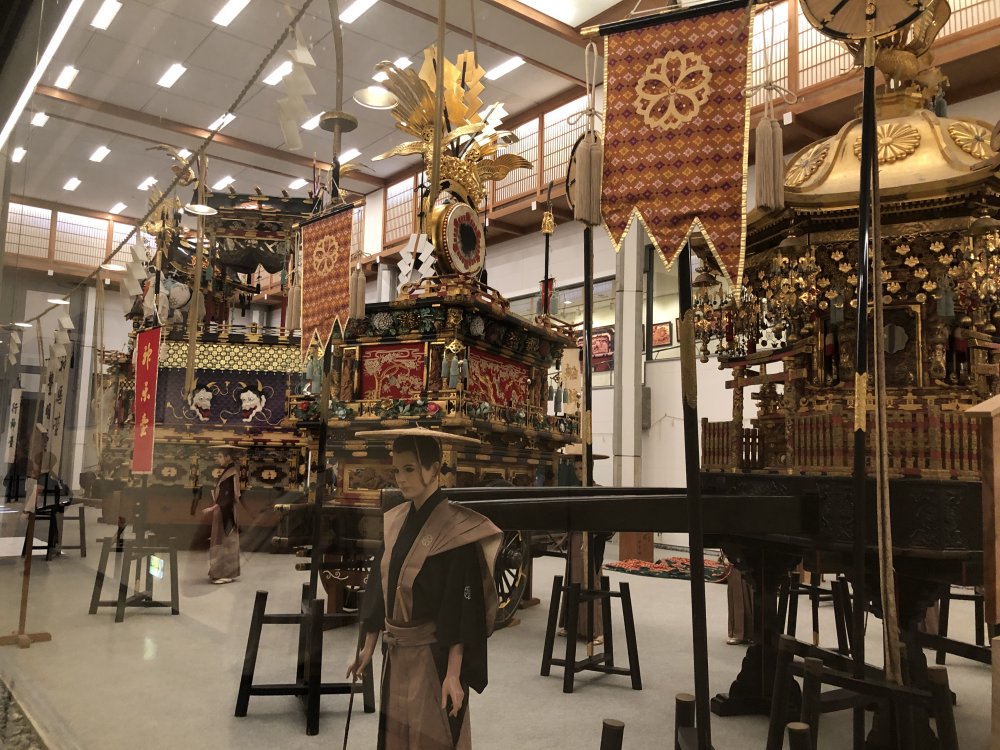
Display of festival floats at the Takayama Festival Floats Exhibition Hall. Takayama is known for its two festivals held in April and October when the Deities of Hie Shinto Shrine and the Sakurayama Hachiman Shrine are taken out of the shrines on the Kaguratai (the festival float carrying the Deity) followed by 11 yatais (festival floats) in spring and ten in autumn. Of the 23 festival floats which are usually stored in storehouses located across the township, four are displayed at the Exhibit Hall on a rotating basis.
On the last day of my three-days excursion, I visited Takayama for the first time in more than thirty years. Having stayed in Takayama for two nights, I was amazed to see how the city had changed. The station was much more modern. There were many large hotels owned by foreign groups around Takayama Station. My last visit had been very brief, concentrating on the former high street of old Takayama. Having guessed as much before visiting the city, I had booked a guided tour through the Takayama Silver Human Resources Center. You may wonder what “Silver” means. This basically means elderly persons, derived from JR first introducing “Silver Seats”, priority seats for the elderly on their train services. Two guides from the Takayama Silver Human Resources Center came to pick me up early morning to take me on a three-hour tour around Takayama City.Takayama is located about 150 kilometers north of Nagoya, and 120 kilometers south of Toyama. It takes roughly two hours and half from Nagoya and an hour and half from Toyama by Limited Express on the JR Takayama Line. Since Takayama City merged with nine neighboring towns and villages in 2005, it became the largest city geographically, with the current city area larger than Osaka Prefecture and as large as Tokyo Prefecture. It should also be pointed out that full bloom of cherry blossoms in spring is about two weeks later than in major cities on the plains as central Takayama City is at an altitude of 550 meters above sea level. Takayama City is known as the Little Kyoto (sho-Kyoto) of the Hida Region. Many feudal lords replicated the features of Kyoto when developing their castle towns in their feudal domains. In order to be called Little Kyoto, the town had to have several features. A grid-pattern town layout, rivers, temples and traditional handcraft.
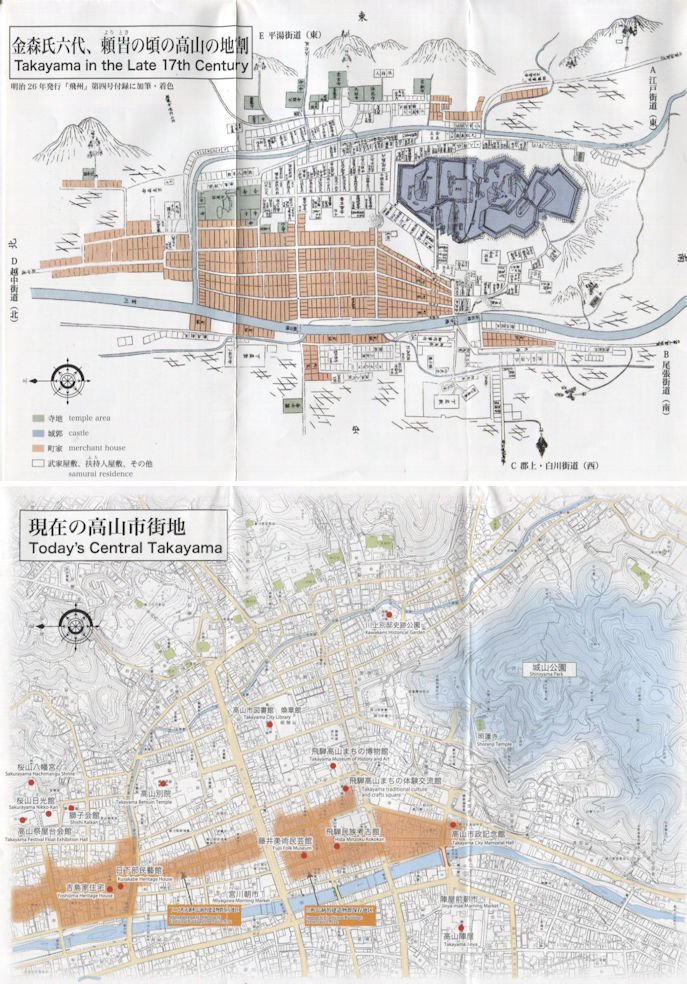
Map of central Takayama in the late 17th century (upper map) and as of today (lower map). The upper map shows the castle in gray on the right, with the merchant district in brown, and the samurai residence uncolored, all basically within the two rivers. This was the original grid-shaped layout of the castle township of Takayama. If you compare this with the lower map, you recognize the merchant district in brown , while the samurai residence and the castle were dismantled in the late 17th century. This map was extracted from a brochure issued by Takayama City "Higashiyama Walking Course". Unfortunately I was not able to find any links for downloading the brochure.
My guides first took me to the concourse of JR Takayama Station, where
the art of Hida carpenters is displayed through their magnificent work
on the wooden festival floats. I first did not understand why they started
the tour from there, but the reason became apparent as we continued the
tour. From the station we went east to the next destination, Hida Kokubunji
Temple.
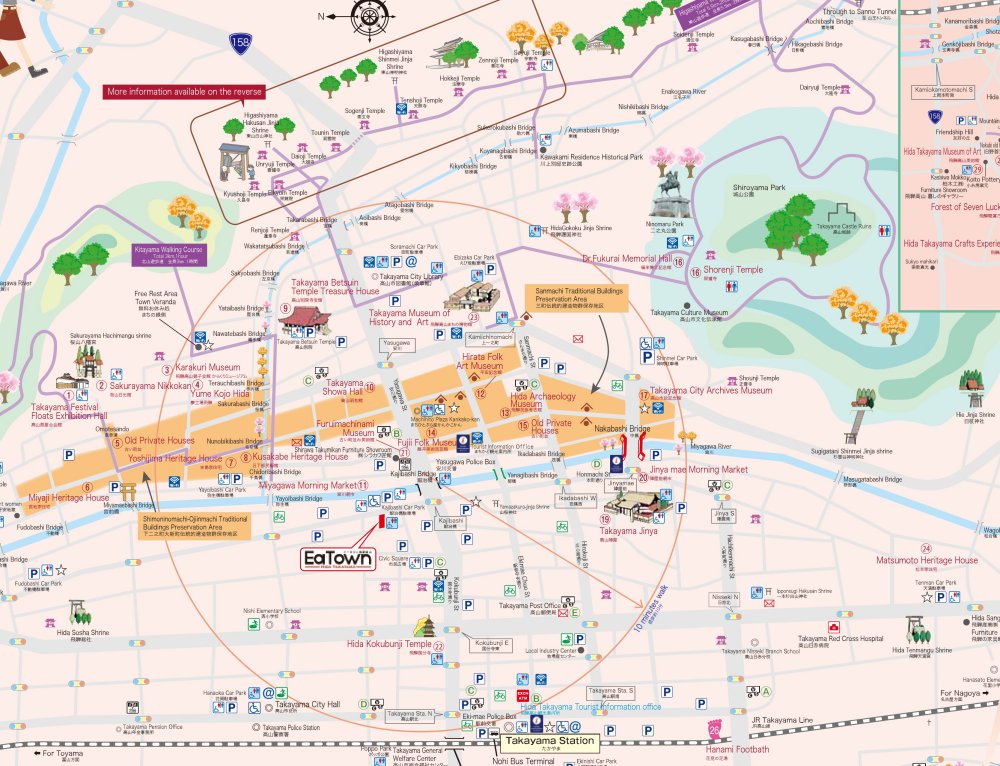
A map of the central Takayama extracted from a map obtained from Takayama City's website to give you a better idea of the route my guides took. We started from JR Takayama Station at the middle bottom, traveled north east to Hida Kokubunji Temple in red marked 22, went further east to cross Miyagawa River. We then went north along the Miyagawa River to the Shimonomachi-Ojinmachi Traditional Buildings Preservation Area (the brown area on the very left), further east to Sakurayama Hachiman Shrine, and then east south along Enakogawa River to visit the Higashiyama Temple area. We finally went downhill back to the city center toward Takayama Jinya marked 17 on the right edge of the brown historic merchant district.
In 741, Emperor Shomu issued a decree that a temple should be established in each of the more than 60 regions throughout Japan to pray for peace in the country through Buddhism. The Buddhist temples were called Kokubunji. Most of the Kokubunji temples have been lost or succeeded by other temples. Hida Kokubunji is one of the rare cases where the Kokubunji still exists in its original location. The original buildings have all been lost, but the current main temple building (hondo) which according to the temple’s website was built in the 15th century by the latest, remains to this day, and has been designated as an important national cultural property. Beside the hondo is a magnificent ginko tree estimated to be at least 1250 years old, meaning it must have been here from when the original Kokubunji was built. Originally, seven-story pagodas were built at all Kokubunji temples, which have all been lost. Hida Kokubunji has a 22 meters high three-story pagoda built in 1821, the tallest in the Hida region.
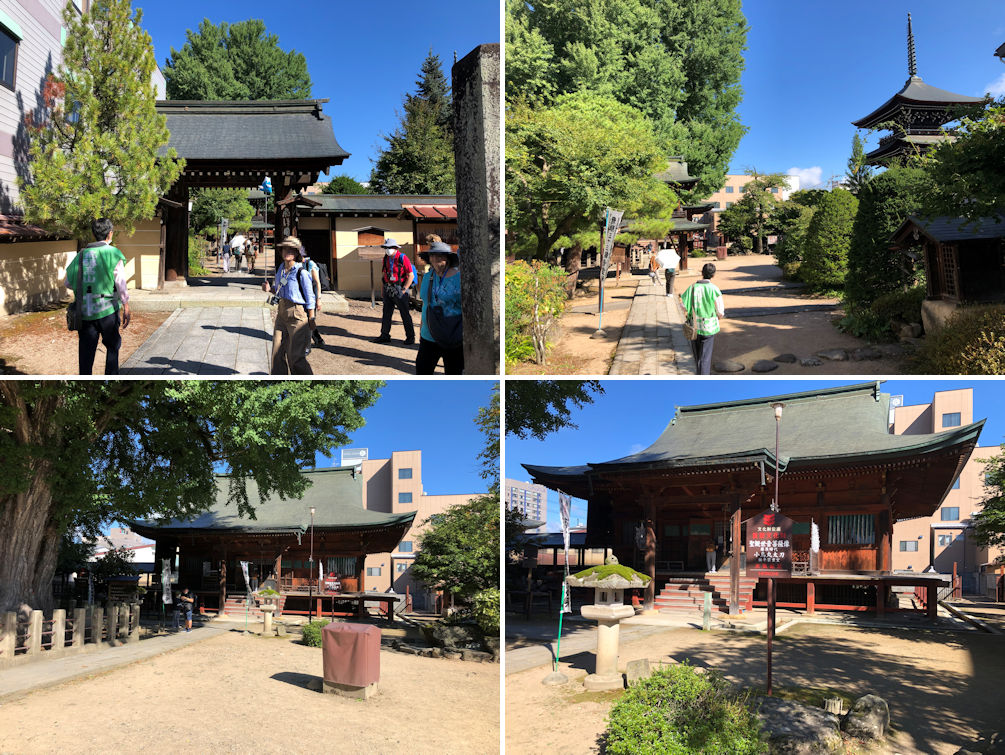
The entrance gate to the temple (upper left). As you enter the gate into the temple grounds, you get a sight of the three-story pagoda (upper right). The main temple building with the 1250 years old ginko tree on its right (lower left) and a closer look at the main temple building built in the 15th century by the latest, and designated as an important national cultural property.
We went east and crossed a river, Miyagawa River. The castle township of old Takayama was created in the late 16th century when the feudal lord Nagachika Kanamori constructed Takayama Castle (for more info on Nagachika Kanamori, please click here). The township was protected from the west by Miyagawa River, and the north and east by Enako River which flows into Miyagawa River at the north western perimeter. The two rivers served as outer moats of Takayama Castle. The township was laid out with the merchant district on the western side, and the samurai residence area on the eastern side. The merchant district has retained its heritage to this day, while the samurai residences were all dismantled together with the castle in the late 17th century, when the governing Kanamori Family were reassigned to a feudal domain in Yamagata Prefecture. The grid-pattern town layout has been retained to this extent.
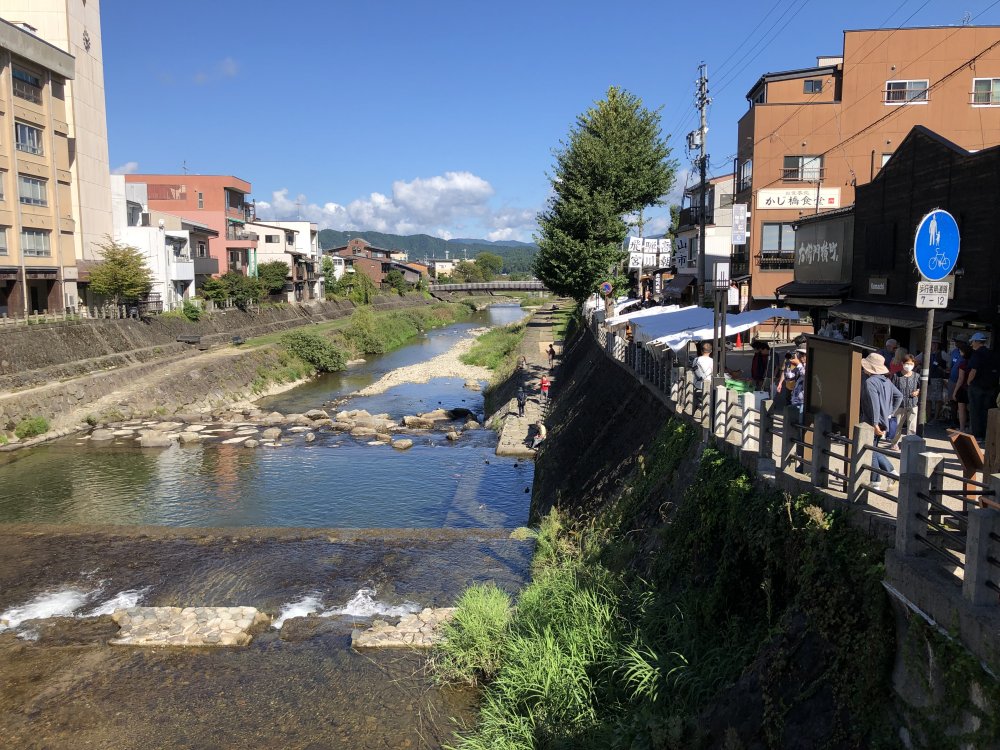
We crossed Miyagawa River to enter the historic merchant district.
The guide introduced us to the Miyagawa morning market. Morning markets are held in many parts of Japan, with farmers, fishermen, craftsmen among others offering their products to customers at temporary stalls. There are a handful of morning markets with a long tradition, Wajima in Ishikawa Prefecture, Katsuura in Chiba Prefecture as well as Takayama with two, one along Miyagawa and another in front of the Jin-ya that I’ll introduce later. Visit this site if you are interested (https://www.asaichi.net/language/english.html). We strolled along Miyagawa River till we reached Enako River. Our guides told us the difficulty of maintaining the number of stalls due to retirement and other issues.
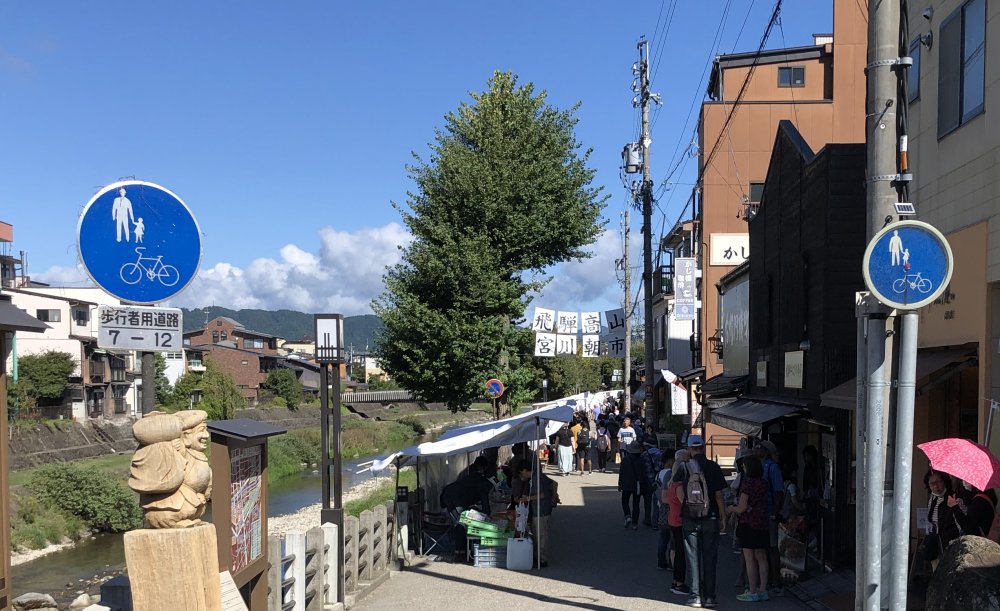
The Miyagawa Morning Market open every day from early morning to noon. The stalls extend along Miyagawa River.
We crossed Enako River to visit the Shimoninomachi-Ojinmachi district which has been designated as an Important Preservation District for Groups of Historic Buildings. This is an area outside of the township in the Kanamori Family reign, developed after Takayama came under direct control of the Tokugawa shogunate, home to many wealthy merchants. Although the district experienced many fires from the Meiji era and onward, it has been restored to maintain its original features. One interesting feature was the zig-zag route (to prevent direct approach by the enemy to the castle), reminiscent of the days of civil wars.
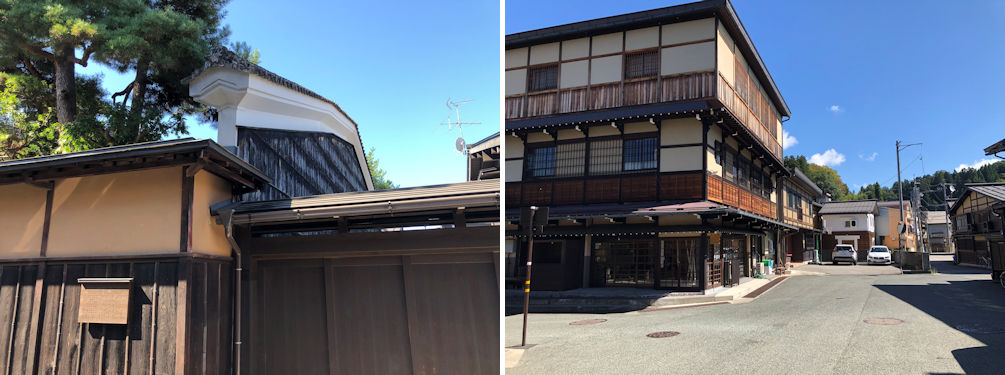
A grand udatsu which is a wall to prevent the spread of fire at one of the wealthy merchant's residence(left), and the zig-zag-route reminiscent of the days of the civil wars (right).
We went east to visit the Sakurayama Hachimangu Shrine. Almost all festivals are held to pay respect to the local Deities and the shrines that worship them. The autumn Takayama Festival is dedicated to the Sakurayama Hachimangu Shrine. There are many Hachimanguus across Japan where God Hachiman is worshipped. Historically the first Hachimanguu was founded in the early 8th century in Usa, Ooita Prefecture. God Hachiman was believed to be the incarnation of the 15th mythical Emperor Oujin. Hence the Deity worshipped at this shrine is Emperor Oujin (click here to learn more about Hachimanguu shrines). The shrine has a typical atmosphere that can be observed in Shinto shrines in mountaneous areas. Adjacent to the shrine is the Takayama Festival Floats Exhibition Hall and the Sakurayama Nikkokan that I’ll touch upon later.
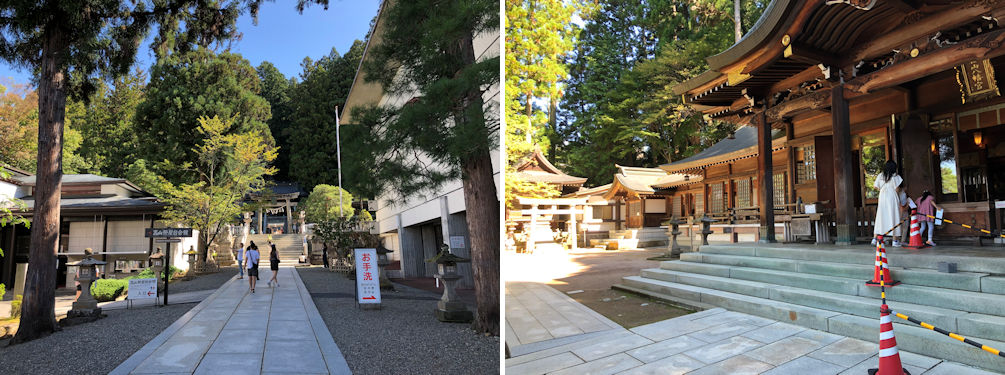
The approach to Sakurayama Hachimanguu Shrine (left), and the main shrine building (honden) (right). The warrior God Hachiman is worshipped at Hachimanguus. Historically the first Hachimanguu was founded in the early 8th century in Usa, Ooita Prefecture. God Hachiman was believed to be the incarnation of the 15th mythical Emperor Oujin. Hence the Deity worshipped at this shrine is Emperor Oujin.
Our guides next took us to the Higashiyama (meaning eastern mountain) temple area. This is the area on the eastern hill slope where Nagachika Kanamori ordered temples to be built or relocated to on the eastern side of Enako River outside of the castle town perimeter. This is the same as Kyoto’s Higashiyama housing temples such as the famous Ginkakuji Temple. Starting from Kyushoji Temple (Soto sect: originally a subsidiary temple of Unryuuji), we visited the temples of Unryuji (Soto sect: one of the oldest and most prestigious temples in Takayama), Daioji (Jodo sect: relocated from nearby to this place in the late 16th century), Touun-in (Jodo sect: established in the early 17th century), Sogenji (Soto sect: established in 1609 to house the grave of Nagachika Kanamori, the first feudal lord of Takayama), Tenshoji (originally a Tendai sect temple converted to Jodo sect in the early 16th century), Hokkeji (Hokke sect: established in 1558) , Zennoji (Soto sect: made a subsidiary of Sogenji), and Soyuji (Rinzai sect: established in the early 17th century). The majority of temples are zen Buddhism temples (Soto and Rinzai sects) which provided the spiritual backbone to samurai warriors, and the Jodo sect that received patronage from the Tokugawa Familiy. All the temples have a long history as well as noted buildings and gardens. Particularly interesting were the bell tower of Unryuji Temple and the grand Sanmon Gate of Daioji Temple. I understand that the former was not originally a bell tower but a building in Takayama Castle before it was dismantled, built in memory of Nagachika Kanamori’s eldest son, who lost his life at the age of 19 at Nijo Castle in Kyoto when Nobunaga Oda, the then superior of Nagachika was assassinated in 1582.
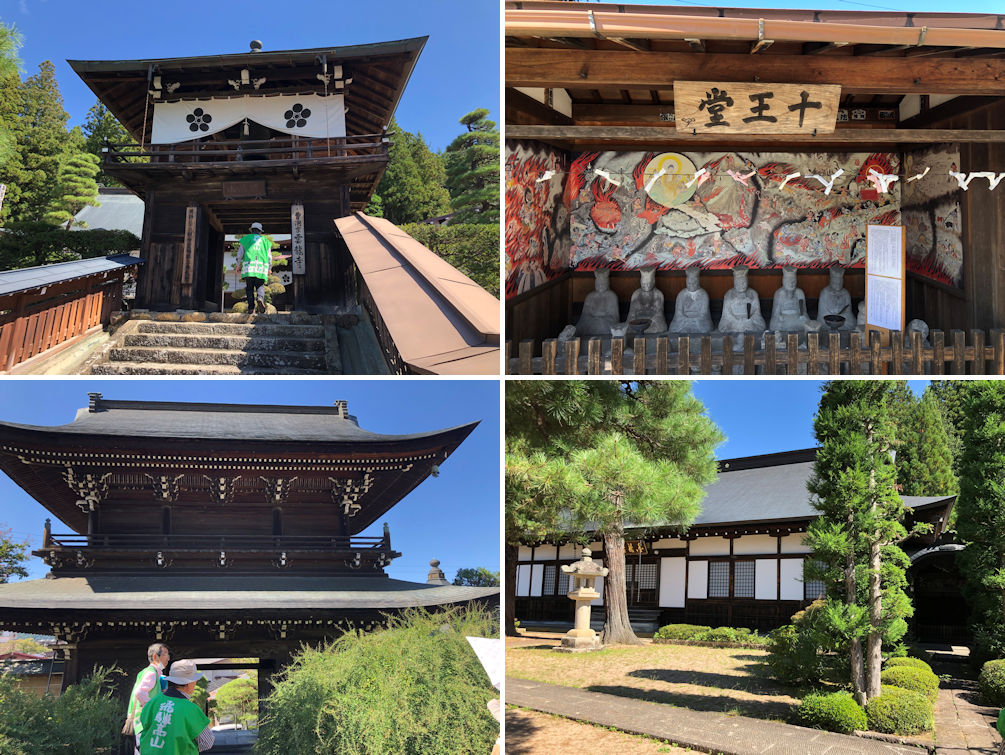
The bell tower of Unryuji Temple relocated from Takayama Castle upon its dismantlement (upper left), the Juuoudou (shrine of the ten Gods of Hell) with a painting of hell in the back. The shrine was for people to repent and pray for merciful judgement by the Gods after they end their lives on earth (upper right), the grand Sanmon Gate (lower left) both of Daioji Temple, and the main temple building of Sogenji Temple housing the grave of Nagachika Kanamori (lower right).
We came down the hill from Higashiyama to visit Takayama Museum of History and Art (Machi no Hakubutsukan). This is a museum featuring Takayama’s history, festivals, craftsmanship, the Kanamori Family amongst others in former stone warehouses of two wealthy merchants of the Edo area. Some English description is provided, and well worth a visit to obtain knowledge.
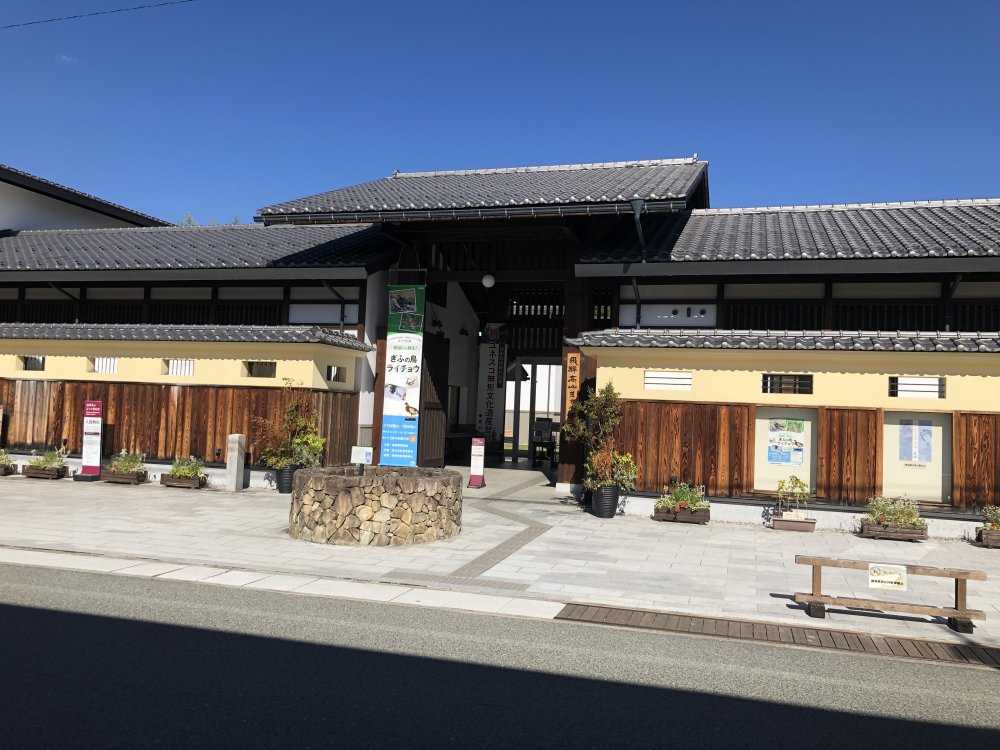
Entrance to the Takayama Machi no Hakubutsukan. The museum displays on the first and second floors of former stone warehouses related to Takayama's rich heritage is certainly worth visiting. Admission is free.
It had already taken more than three hours. Our guides led us to the Takayama Jinya, which served as the governor’s office of the Tokugawa shogunate after Takayama became a tenryou, meaning a domain under direct control of the Tokugawa shogunate. I thanked our guides for an excellent three hours’ tour of the city. Above all I was so impressed with their enthusiasm, and how highly they thought of Takayama’s heritage including those originating in the Kanamori Family's reign, to say nothing of their indepth knowledge.
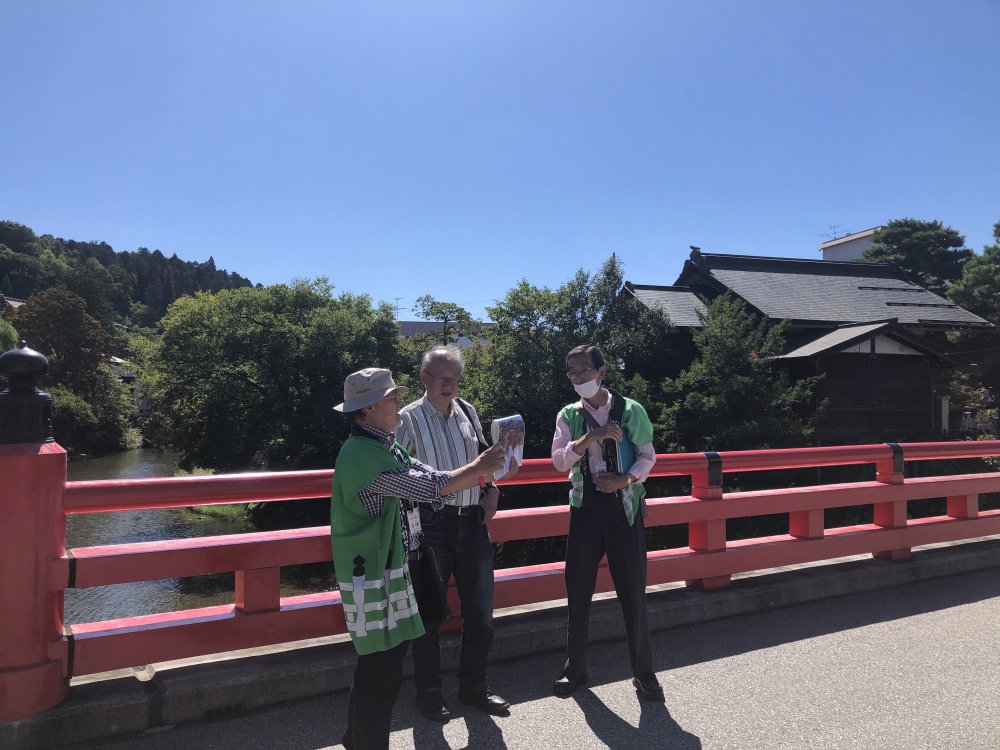
On Nakabashi over Miyagawa River, just before arriving at Takayama Jinya, with the expert guides Mr. Sawa (left) and Mr. Kose (right).
I parted with our guides and entered the Jinya. The Tokugawa shogunate directly ruled about 60 domains (tenryo) across Japan in the Edo era (1603-1868), while more than 200 feudal lords pledging loyalty to the Tokugawa governed their feudal domains. Areas of strategic importance, such as strategic location, gold and silver mines, ports were retained as tenryo. Examples are Hita (Oita Prefecture), Nagasaki, Iwami Silver Mine, Sado (gold mine). In case of Takayama, it is believed that the Tokugawa shogunate ousted the Kanamori Family and took direct control, because of its rich resources (silver, gold, timber, gunpowder, etc.). Governors were assigned to tenryos, and their offices were called, bugyosho, daikansho, or jinya as in the case of Takayama or Iwami Silver Mine. The Takayama Jinya is the only jinya that retains a large portion of its original buildings to this day, and as such has been designated as a national historic site. It can easily take an hour strolling through all the rooms following the guided route. But well worth the admission fee of 440 yen to slip back in time and walk through the rooms of the governor, waiting rooms for guests, all with different tatami flooring rims depending on the person’s social ranking, as well as the court room and the rice warehouses dating back to the early 17th century.
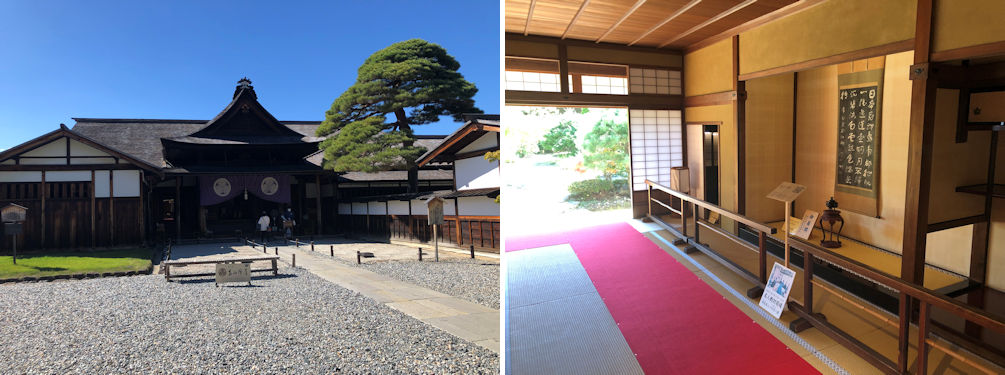
The entrance to Takayama Jinya (left) and the Governor's reception room (right). The room hosted one of the shogi (Japanese chess) Meijinsen titlematches in 2015.
I left the jinya to visit the Sanmachi Traditional Buildings Preservation Area. After crossing Miyagawa River, we entered Sanmachi-doori, one of the three streets stretching from the south to the north along Miyagawa River. This was the street I went through on my first visit to Takayama more than thirty years ago. It hadn’t changed after all these years. In particular I recalled the two sake breweries with their balls made of cedar leaves hanging down from the eave, a symbol of sake breweries. It was from here that I started my quest to gain in-depth knowledge of Japanese sake. I was happy to see the street so busy with visitors, and having retained its Edo-era features.
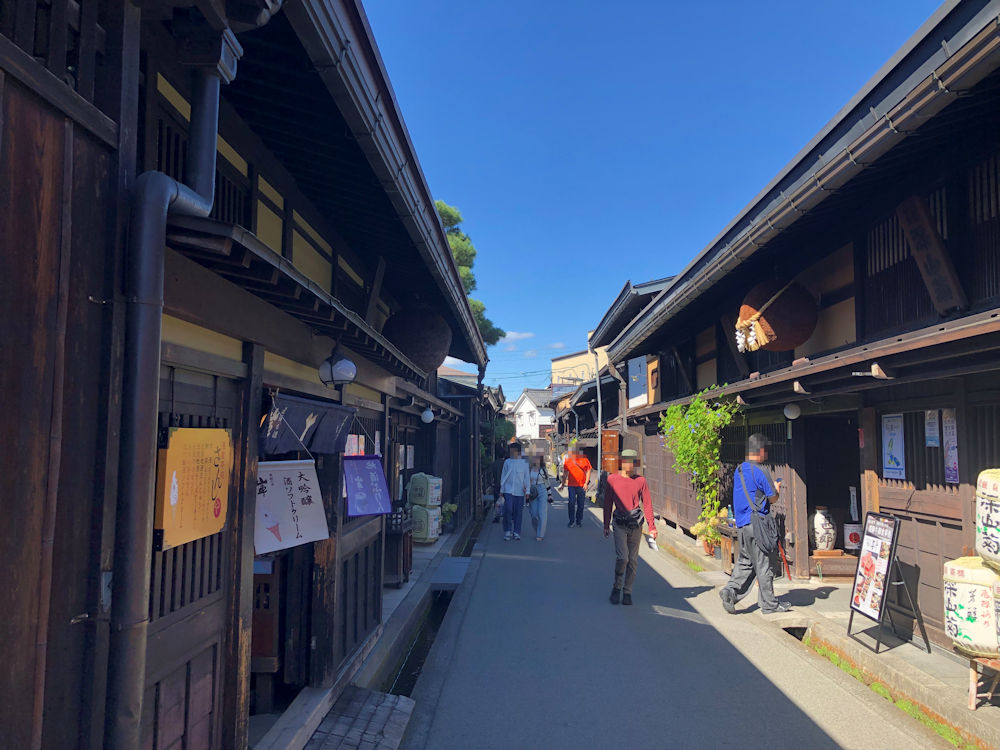
The two sake breweries sitting opposite to each other with their balls made of cedar leaves hanging down from the eave along Sanmachi-doori. It was from here that I started my quest to gain in-depth knowledge of Japanese sake.
Before leaving Takayama, we paid a visit to the Takayama Festival Floats Exhibition Hall and Sakurayama Nikkokan. Takayama is known for its two festivals held in April and October when the Deities of Hie Shinto Shrine and the Sakurayama Hachiman Shrine are taken out of the shrines on the Kaguratai (the festival float carrying the Deity) followed by 11 yatais (festival floats) in spring and ten in autumn. Hida carpenters are known for their craftsmanship. I lieu of paying tax through crops, the Hida region dispatched carpenters to the old capitals of Nara and Kyoto to help build the palace and temple buildings. The Kanamori Family brought Kyoto’s culture to Takayama, as evidenced by how they built the township. After Takayama became a tenryo, Edo culture was also brought to the town resulting in a magnificent blend of the culture One classic example is the two festivals, with the 23 festival floats built in the Edo era and preserved to this day, as well as the karakuri marionette, which is a sort of surprise transformation of the puppets. Karakuri performance is for instance featuring doll characters of Priest Hotei and a boy and girl, when suddenly the children leap onto a spring and then onto Hotei’s shoulders, and the Hotei’s fan splits open to show a flag. Of the 23 festival floats which are usually stored in storehouses located across the township, four are displayed at the Exhibit Hall on a rotating basis. Adjacent to the Exhibition Hall is the Sakurayama Nikkokan, displaying a one tenth size replica of Nikko Toshoguu in Tochigi Prefecture dedicated to the founder of the shogunate, Ieyasu Tokugawa (click here to read about Nikko Toshoguu). I understand it took 33 carpenters 15 years to complete this magnificent replica, on display to highlight the craftsmanship of Japanese carpenters. The 1,000 yen admission fee allows entry to both museums.
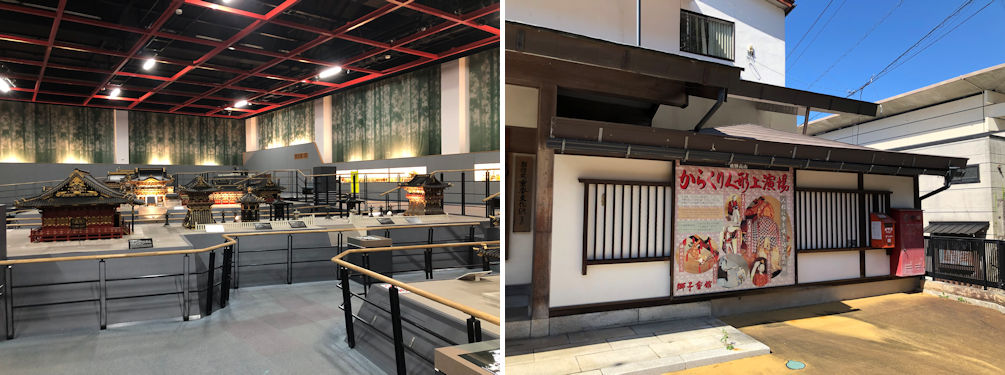
The detailed one tenth size replica of Nikko Toshoguu at Sakurayama Nikkokan (left). It was sad to see the museum featuring karakuri puppets closed permanently.
It was a very rewarding day excursion of Takayama. A very special thanks to Messrs. Kose and Sawa for making this possible. I understand they have English-speaking guides at the Takayama Silver Human Resources Center. Why not ask for their availability.